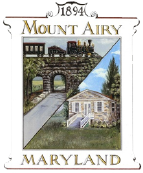- Home
- Government Services
- Boards and Commissions
- Mount Airy Sustainability Commission
- Mount Airy Community Garden
- Community Garden Sign Garden Project
Community Garden Sign Garden Project
MOUNT AIRY NATIVE PLANTS GARDEN
at the
Mount Airy Community Garden
714 Rising Ridge Road, Mount Airy, Maryland
Why plant native species? Native insects, like butterflies and skippers, rely on native host plants very early in their life cycle. Native birds and small mammals eat their seeds. The nectar from native flowers is an important food source for birds, bees, butterflies, skippers, and moths. When native plants are crowded out by invasive species it reduces the amount of native plant cover and the number of native species growing in the ecosystem. The decline is felt throughout the food web — for example, it can cause a decrease in insect and songbird diversity. The damage can usually be reversed by getting rid of invasive plants and encouraging natives. There’s also another important reason to plant natives: pollination. According to the University of Maryland, “Many Marylanders grow fresh fruits and vegetables for their families. Unlike commercial operations, home food gardens rely almost exclusively on native pollinators. As our wild native plant populations succumb to invasive plants, the pollinators that rely upon them disappear.”
The following native plants are great additions to any garden:
Bird’s-foot Violet Viola pedata Linnaeus. Perennial
Height 4-10″. Plant 4-6″ apart. Does well in full sun but will tolerate partial shade. Prefers sandy or gravelly, slightly acidic, well-drained soil with dry to medium moisture. Blooms April to June, with large, light violet-blue flowers almost the size of pansies, and may also bloom again in the fall. The Bird’s-foot Violet gets its name from its distinctive “bird’s-foot”-shaped leaves. Attracts bees and butterflies, and is a host plant for the Regal fritillary butterfly.
(Bird’s-foot Violet )
Black-eyed Susan Rudbeckia hirta. Perennial
Height 2-3′. Plant 12-16″ apart. Spreads by rhizomes but also self-seeds. Prefers full to partial sun and rich, well-drained moist to dry soil. Blooms June to October with 2-3″ golden-yellow, daisy-like flowers with a dark brown “eye.” There are many similar varieties of Black-eyed Susans, like Rudbeckia goldsturm, but R. hirta is the official Maryland state flower and a Maryland native species. Attracts a wide range of pollinating insects including beetles, moths, small butterflies, and bees; birds feed on the seeds. The Silvery Checkerspot butterfly and the Wavy-lined Emerald moth use Rudbeckia species as a host plant.
(Black-eyed Susan )
Blue Wild Indigo Baptisia australis (Linnaeus) R. Brown. Perennial
Height 3-5′; spread about 3′. Plant 18-24″ apart. Prefers full sun to partial sun. Grows well in all well-draining soil types and likes medium moisture — will need water while it’s being established and then can handle drier soil and is relatively drought tolerant. It is not dependent on soil pH but does best in slightly acidic to neutral soil. Blooms from May to June with blue-purple flowers that resemble pea blossoms (the genus Baptisia is a member of the pea family) but may not bloom until the second or third year. If not deadheaded will produce ornamental seed pods which will darken and rattle in the wind. Mildly toxic if eaten. Deer resistant.
(Blue Wild Indigo )
Butterfly Milkweed Asclepias tuberosa Linnaeus subsp. tuberosa. Perennial
Height 2-3′. Plant 18″ apart. Prefers direct sunlight and dry to moist soil (very well-drained, poor, dry, coarse or sandy soil — likes rock outcroppings). Prefers soils with neutral to slightly acidic pH. Once established uses low water and can tolerate drought conditions because of deep taproots. Blooms May to August with clusters of bright orange flowers. Does not have the milky sap found in other milkweeds, and so is much less toxic. It does produce milkweed’s characteristic seedpods that burst with seeds on silken “parachutes.” Host to Monarch, Gray Hairstreak, and Queen butterflies and attracts bees, butterflies and hummingbirds. Low maintenance. Deer resistant.
(Butterfly Milkweed )
Carolina Rose or Pasture Rose Rosa carolina Linnaeus var. carolina. Deciduous shrub
Height 3-4′, spread 4-5′. Likes full sun. Prefers well-drained, moist, sandy to loamy soil
but can tolerate some clay, with an acid to neutral PH. Prefers deep and regular watering at
the base of the plant while being established but is mostly drought tolerant afterwards due to a deep taproot, and spreads through rhizomes. Can tolerate harsh winters. Blooms May to August with yellow centered, pink blossoms. Host plant for the Apple Sphinx Moth caterpillar and attracts bees and butterflies. The bright red rosehips are a popular food source for fruit-loving birds. Deer resistant.
(Carolina Rose or Pasture Rose )
Hairy Beardtongue Penstemon hirsutus (Linnaeus) Willdenow. Perennial
Height 1-2′. Plant 10-12″ apart. Full sun to partial shade. A very hardy plant that does well in any well-drained soil, from average clay to medium garden soil. Prefers dry to moist soil and is typically found in rocky fields, bluffs, or open woods. Blooms in May and June with clusters of lavender and white, trumpet-shaped flowers, and leaves turn red in the fall. Attracts hummingbirds and pollinators, and is a host plant for butterflies, including the Baltimore Checkerspot. Deer resistant.
(Hairy Beardtongue)
Little Bluestem Schizachyrium scoparium (Michaux) Nash var. scoparium. Perennial grass
Height 2-3′, forms dense mounds about 1′ in diameter. Plant 12-18″ apart. Prefers full sun and grows best in well-draining, poor soils with dry to medium moisture, like sunny meadows. Does not like very fertile soil or persistently moist conditions. Tolerates heat, drought, and humidity. In the spring new stems have a blueish tint, and the grass turns copper, brown, or mahogany red in the fall with white seed tufts. Blades of grass poking up in the snow provide shelter for overwintering birds and the seeds are a valuable food source for them. It’s a host plant for Swarthy skippers, Dusted skippers, Crossline skippers, Leonard’s skippers, Indian skippers, and Cobweb skippers.
(Little Bluestem)
Narrow-leaved Evening Primrose Oenothera fruticosa Linnaeus. Perennial
Height 1½ -2′, width 1-3′; spreads by rhizomes to form colonies. Plant 12-18″ apart. Likes full sun to partial shade. Prefers light sandy, loamy soils that are well-draining; can tolerate some clay. Likes medium to dry moisture levels and is very tolerant of dry conditions once established. Found in roadsides and disturbed fields, rock outcrops, dry woods, and meadows. Blooms May to July with bright yellow, cup-shaped flowers about 2″ across. Attracts hummingbirds, skippers, butterflies; songbirds eat the seeds. Usually is deer resistant.
(Narrow-leaved Evening Primrose)
Narrow-leaved Mountain-mint Pycnanthemum tenuifolium Schrader. Perennial
Height 2-3′, spread 2-3′. Plant about 18″ apart. Also called Slender Mountain Mint or Common Horsemint. Likes full sun but will grow in partial shade. Needs dry to average moisture and does well in a wide variety of well-draining, slightly acidic soils. Somewhat drought tolerant. Blooms July to September with clusters of small white or pale lavender flowers and has a minty smell; the dried leaves can be used as a flavoring and to make tea. Some people crush and rub the leaves on their skin as a mosquito repellant. Attracts butterflies, skippers, and bees.
(Narrow-leaved Mountain-mint)
New England Aster Symphyotrichum novae-angliae (Linnaeus) Nesom. Perennial
Height 3-5 ft. tall, 2-3 ft. wide. Plant 12-18″ apart to ensure that they have good air circulation; plants too close together in high humidity can encourage powdery mildew. Prefers full sun and rich, moist, well-draining, slightly acidic soil, but can tolerate clay/loam. Can tolerate low levels of moisture but needs water in times of drought. Blooms August to October with pinkish-purple flowers with yellow-orange centers. The New England Aster is a larval host for the Monarch, Pearl Crescent, and Gorgone Checkerspot butterflies and the Northern flower moth, and is a nectar source for bees and butterflies. Deer resistant.
(New England Aster)
New York Ironweed Vernonia noveboracensis (Linnaeus) Michaux. Perennial
Height 3-8′, spread about 3-4′. Plant about 2′ apart. Full to partial sun, likes moisture but performs well in moist to average slightly acidic soil but not dry - any texture. Will need water in drought while it’s being established. Tolerates high heat and humidity. Often found in wet meadows and pastures, streambanks, low-lying woods, and marshes. Blooms August to September with clusters of fluffy dark purple flowers 3-4′ across. Attracts bees and butterflies; birds eat the seeds. Deer resistant.
(New York Ironweed)
Smooth Blue Aster Symphyotrichum laeve (Linnaeus) A. & D. Love. Perennial
Height 2-4′, spread 2-3′. Plant 12″ apart. Full sun to partial shade. Prefers sandy loam or clay loam soil with dry to medium moisture. Drought tolerant once established. Blooms August to October with daisy-like lavender flowers with yellow centers. Unlike other asters it has a smooth stem, hence the name. Attracts bees, butterflies, and skippers; host plant for the Pearl Crescent butterfly.
(Smooth Blue Aster)
Virginia Sweetspire Itea virginica Linnaeus. Deciduous shrub
Height 4-7′ with similar spread; spreads by suckering roots. Likes full sun; will grow part shade, but not to its full potential. Prefers rich, well-draining soil that is slightly acidic. Likes medium to wet moisture levels and will need to be watered while being established, then is drought tolerant. Will do well in very hot conditions as long as it gets water. Blooms May and June, with white fluffy “tails” of flowers. Foliage turns bright red in the fall. Attracts bumblebees, hummingbirds, and butterflies and provides seeds for birds. Deer resistant.
(Virginia Sweetspire)
White Heath Aster Symphyotrichum ericoides (Linnaeus) Nesom. Perennial
Height 1-3′. Spreads slowly by rhizomes; branches to form a bushy appearance. Plant 12′′ apart. Prefers full sun and average to dry conditions. The soil can contain significant amounts of loam, clay, or gravelly material; does well in sand and gravelly soils. Natural habitats include pastures, dry or moist meadows, sandy, gravelly and rocky soils, disturbed soils, dunes, shores, and roadsides. Blooms August to October with clusters of tiny, daisy-like flowers. Drought tolerant. Attracts honeybees and bumblebees, butterflies, moths, and skippers, and is a host plant for Pearl Crescent and Field Crescent butterflies and the Wavy-Lined Emerald Moth.
(White Heath Aster)
Wild Bergamot Monarda fistulosa Linnaeus. Perennial
Height 3-4′, spread about 2-3′. Plant about 18″ apart to promote air circulation and discourage powdery mildew. Also called Bee Balm or Horsemint. Prefers full sun but does well in light shade, especially in hot climates. Does well in a variety of soils as long as they are well-draining; tolerates clay and rocky soils. Does not like long-term wet conditions. Blooms July and August with fluffy light purple flowers. Has a light minty smell and historically has been used for medicinal purposes, including teas and poultices. Attracts pollinators like swallowtail butterflies, hummingbird moths, and bumble bees; host plant for the Raspberry Pyausta butterfly. Deer resistant.
(Wild Bergamot)
Yellow Wild Indigo Baptisia tinctoria (Linnaeus) R. Brown. Perennial
Height 2-3′, spread 2-3′. Plant 2′ apart. Needs full to partial sun. Does well in average or sandy well-draining soil with dry to medium moisture that is slightly acidic. Often found in open woods and fields, pine barrens, and meadows. Blooms May to September with bright yellow flowers that resemble pea blossoms (the genus Baptisia is a member of the pea family). Produces small seed pods that darken to purple-black. Host plant for the Wild Indigo Duskywing, Frosted Elfin, and Orange Sulfur butterflies as well as Io moths and skippers. Also host for the Genista Broom, Indigo Stem, and Borer moths. Deer resistant.
(Yellow Wild Indigo)
The Mount Airy Native Plants Garden is the Eagle Project of
William Finn
BSA Troop 1191








